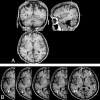Frequency and location of dilated Virchow-Robin spaces in elderly people: a population-based 3D MR imaging study
- PMID: 21349956
- PMCID: PMC7965873
- DOI: 10.3174/ajnr.A2366
Frequency and location of dilated Virchow-Robin spaces in elderly people: a population-based 3D MR imaging study
Abstract
Background and purpose: dVRS have been previously associated with aging and cerebrovascular diseases. However, little is known about their prevalence and topographic distribution in the general elderly population.
Materials and methods: dVRS were evaluated by using high-resolution 3D MR imaging in 1826 subjects enrolled in the 3C-Dijon MR imaging study. On T1-weighted MR imaging, dVRS were detected according to 3D imaging criteria and rated by using 4-level severity scores based in the BG or in the WM. The number and anatomic location of large dVRS (≥3 mm) were recorded.
Results: dVRS were observed in the BG or WM in every subject. The severity of dVRS was significantly associated with higher age in both the BG and WM, whereas sex was related to the severity of dVRS only in the BG. Large dVRS were detected in 33.2% of participants. Status cribrosum was found in 1.3% of participants. dVRS were also highly prevalent within the hippocampus (44.5%) and hypothalamus (11.6%).
Conclusions: dVRS are always detected in the BG or WM in elderly people, and large dVRS are also prevalent. The topographic distribution of dVRS is not uniform within the brain and may depend on anatomic or pathologic characteristics interacting with aging and sex.
Figures




References
Publication types
MeSH terms
LinkOut - more resources
Full Text Sources
Medical
